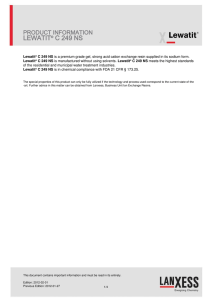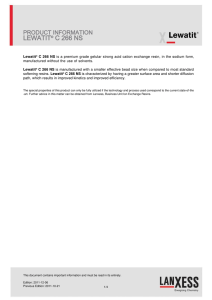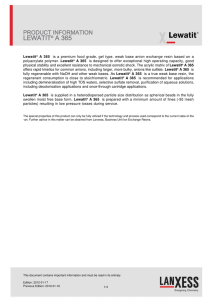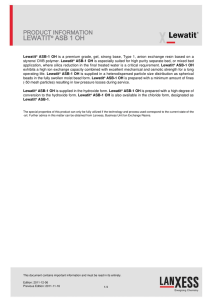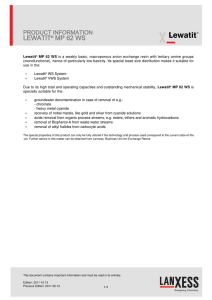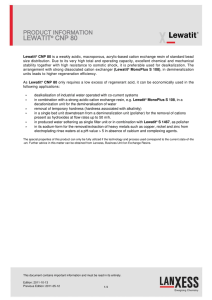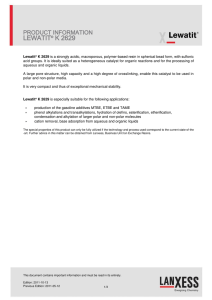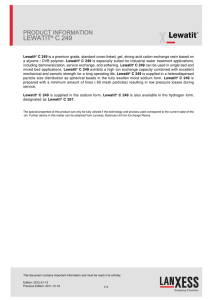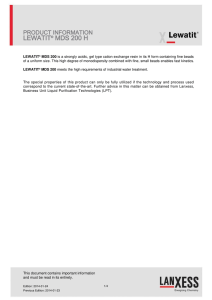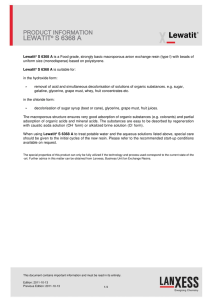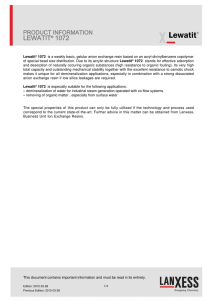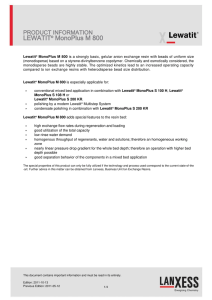Lewatit C 267 C 267 a styrene/DVB polymer.
advertisement
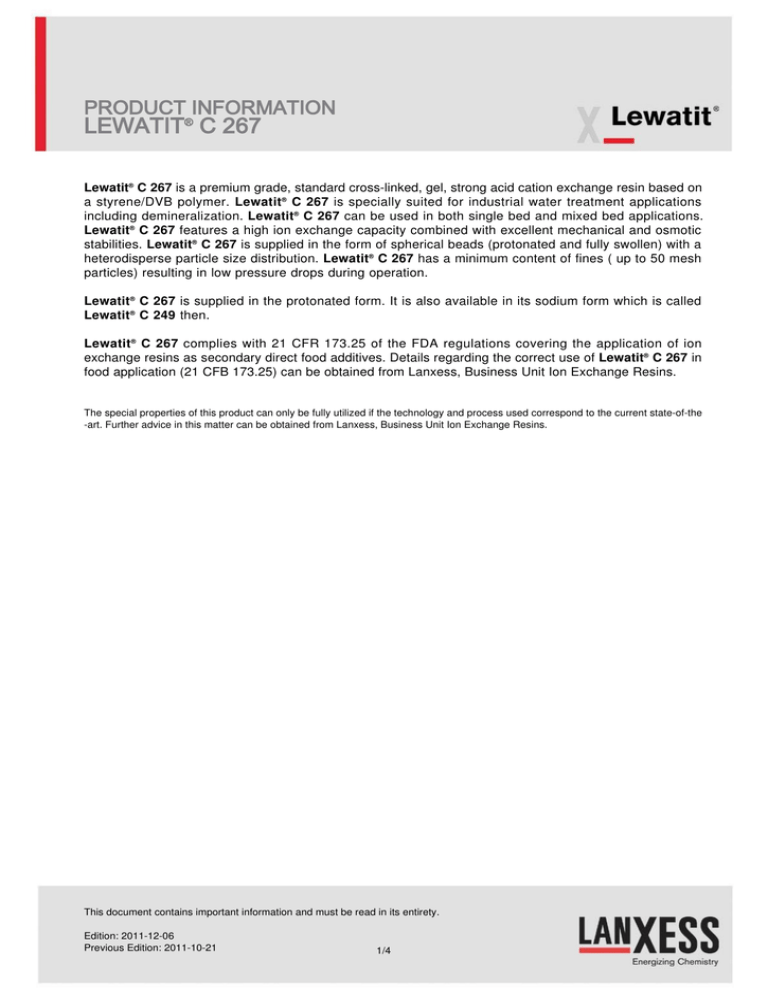
Lewatit® C 267 is a premium grade, standard cross-linked, gel, strong acid cation exchange resin based on a styrene/DVB polymer. Lewatit® C 267 is specially suited for industrial water treatment applications including demineralization. Lewatit® C 267 can be used in both single bed and mixed bed applications. Lewatit® C 267 features a high ion exchange capacity combined with excellent mechanical and osmotic stabilities. Lewatit® C 267 is supplied in the form of spherical beads (protonated and fully swollen) with a heterodisperse particle size distribution. Lewatit® C 267 has a minimum content of fines ( up to 50 mesh particles) resulting in low pressure drops during operation. Lewatit® C 267 is supplied in the protonated form. It is also available in its sodium form which is called Lewatit® C 249 then. Lewatit® C 267 complies with 21 CFR 173.25 of the FDA regulations covering the application of ion exchange resins as secondary direct food additives. Details regarding the correct use of Lewatit® C 267 in food application (21 CFB 173.25) can be obtained from Lanxess, Business Unit Ion Exchange Resins. The special properties of this product can only be fully utilized if the technology and process used correspond to the current state-of-the -art. Further advice in this matter can be obtained from Lanxess, Business Unit Ion Exchange Resins. This document contains important information and must be read in its entirety. Edition: 2011-12-06 Previous Edition: 2011-10-21 1/4 General Description Ionic form as shipped Functional group Matrix Structure Appearance H+ Sulfonic acid DVB / Styrene Gel Brown/black, translucent Physical and Chemical Properties Total capacity* Uniformity Coefficient* Bead size* Effective size Bulk density Density Water retention* Volume change Stability Stability Storability Storability metric units min. eq/l max. mm mm g/l approx. g/ml wt. % max. vol. % H-Form > 90 % (+/- 5 %) H+ --> Na+ at pH-range temperature range of the product temperature range °C max. years °C * Specification values subjected to continuous monitoring. Trace Elements Analysis This document contains important information and must be read in its entirety. Edition: 2011-12-06 Previous Edition: 2011-10-21 2/4 1.9 1.6 0.3 - 1.25 0.52 (+/- 0.06) 800 1.25 49 - 54 -7 0 - 14 1 - 140 2 -20 - +40 Recommended Operating Conditions* metric units max. °C Operating temperature Operating pH-range Bed depth Pressure drop Linear velocity Bed expansion Freeboard min. mm max. kPa max. m/h approx. % per m/h vol. % exhaustion backwash (20 °C) backwash (extern / intern) Volumetric flow rate exhaustion Regenerant type level Regenerant Regenerant concentration Linear velocity regeneration Linear velocity rinse, slow / fast Volumetric flow rate regeneration Volumetric flow rate rinse, slow / fast Rinse water requirement slow / fast BV/h approx. g/l approx. wt. % m/h m/h BV/h approx. BV/h approx. BV 140 0 - 14 800 5 - 50 4 65 - 75 8 - 48 HCl / H2SO4 48 - 320 0.5 - 6 1 - 10 1 - 10 / 5 - 50 4 - 12 2.5 - 8 / 8 - 48 1-2/2-5 * The recommended operating conditions refer to the use of the product under normal operating conditions. It is based on tests in pilot plants and data obtained from industrial applications. However, additional data are needed to calculate the resin volumes required for ion exchange units. These data are to be found in our Technical Information Sheets. ** Regeneration progressive ** After regeneration the listed TOC and resistivity figures might not be achieved again. *** 100m/h for polishing This document contains important information and must be read in its entirety. Edition: 2011-12-06 Previous Edition: 2011-10-21 3/4 Additional Information & Regulations Safety precautions Strong oxidants, e.g. nitric acid, can cause violent reactions if they come into contact with ion exchange resins. Toxicity The safety data sheet must be observed. It contains additional data on product description, transport, storage, handling, safety and ecology. Disposal In the European Community Ion exchange resins have to be disposed, according to the European waste nomenclature which can be accessed on the internet-site of the European Union. Storage It is recommended to store ion exchange resins at temperatures above the freezing point of water under roof in dry conditions without exposure to direct sunlight. If resin should become frozen, it should not be mechanically handled and left to thaw out gradually at ambient temperature. It must be completely thawed before handling or use. No attempt should be made to accelerate the thawing process. This information and our technical advice – whether verbal, in writing or by way of trials – are given in good faith but without warranty, and this also applies where proprietary rights of third parties are involved. Our advice does not release you from the obligation to check its validity and to test our products as to their suitability for the intended processes and uses. The application, use and processing of our products and the products manufactured by you on the basis of our technical advice are beyond our control and, therefore, entirely your own responsibility. Our products are sold in accordance with the current version of our General Conditions of Sale and Delivery. This document contains important information and must be read in its entirety. Edition: 2011-12-06 Previous Edition: 2011-10-21 4/4 Lenntech info@lenntech.com Tel. +31-152-610-900 www.lenntech.com Fax. +31-152-616-289
